Liquid aminos have been the go-to for that umami kick in our kitchens.
Sometimes, though, finding a bottle feels like a treasure hunt.
Lucky for us, the culinary world is chock-full of alternatives that can easily slide into its spot on our spice rack.
We’ve stumbled upon some real gems that promise to keep your dishes just as savory.
You might even have a few of them sitting in your pantry right now.
From the depths of soy sauce to the tang of tamarind paste, we’re here to walk you through the top five substitutes.
These swaps aren’t just about getting by; they’re about elevating your cooking game.
Stick with us, and you’ll be seasoning like a pro in no time.
What is Liquid Aminos?

Liquid aminos are a type of seasoning that is made from soybeans.
The soybeans are fermented and then filtered to create a very high protein concentration.
This concentrate is then mixed with water and salt to create the finished product.
Liquid aminos can be used in many different ways, but they are most commonly used as a seasoning for soups, stir-fries, and salad dressings.
They are also sometimes used as a marinade for meats or vegetables.
Liquid aminos are a good source of protein and contain several essential amino acids.
They are gluten-free, and they do not contain any MSG.
When used in moderation, liquid aminos can be a healthy and delicious way to add flavor to your food.
The 5 Best Substitutes for Liquid Aminos
Liquid aminos, such as the popular brand Bragg’s Liquid Aminos, are a common seasoning used to add flavor to various dishes.
However, if you’re looking for substitutes due to dietary restrictions or ingredient availability, there are several options to consider.
In this guide, we will compare the top 5 substitutes for liquid aminos, discussing their key characteristics and suggesting proper ratios to help you find suitable alternatives.
| Substitute | Key Characteristics | Proper Ratio |
|---|---|---|
| Tamari | Rich, savory flavor; gluten-free alternative to soy sauce | Use an equal amount of tamari as a substitute for liquid aminos |
| Soy Sauce | Salty and umami-rich flavor; commonly used as a substitute for liquid aminos | Use an equal amount of soy sauce as a substitute for liquid aminos |
| Coconut Aminos | Sweet and slightly salty flavor; soy-free and gluten-free alternative | Use an equal amount of coconut aminos as a substitute for liquid aminos |
| Fish Sauce | Pungent and savory flavor; adds depth to dishes | Use half the amount of fish sauce compared to liquid aminos |
| Anchovies | Intense umami flavor; commonly used as a flavor enhancer | Use 1-2 mashed anchovies or 1 teaspoon of anchovy paste as a substitute |
Now, let’s dive into each substitute in more detail:
1. Tamari
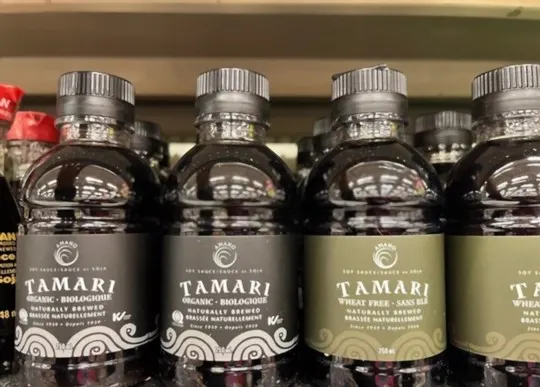
Tamari is a type of soy sauce that originates from Japan.
It is made from fermented soybeans and has a rich, umami flavor.
Tamari is used in many Japanese dishes, such as sushi and tempura.
It is also a popular ingredient in dipping sauces and marinades.
Tamari is an excellent source of protein and amino acids and rich in vitamins and minerals.
Because of its bold flavor, Tamari can be used sparingly to add depth and complexity to dishes.
It is also a delicious way to add saltiness to food without using table salt.
Whether you are cooking Japanese cuisine or looking for a new way to add flavor to your recipes, Tamari is a great choice.
- Key Characteristics: Tamari offers a rich, savory flavor similar to soy sauce. It is a gluten-free alternative to liquid aminos, making it suitable for those with gluten sensitivities.
- Proper Ratio: Use an equal amount of tamari as a substitute for liquid aminos. Adjust other seasonings to balance the flavors.
2. Soy Sauce
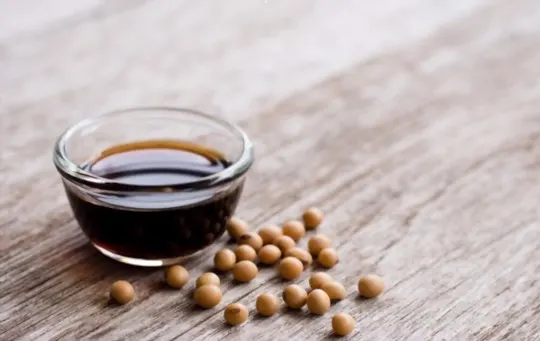
Soy sauce is a staple of Asian cuisine, and it’s easy to see why.
This dark, salty condiment adds a rich depth of flavor to any dish, and it’s also incredibly versatile.
Whether using it as a marinade, a dipping sauce, or simply a seasoning, soy sauce can elevate your cooking to new heights.
But what exactly is soy sauce? Essentially, it’s a fermented paste made from soybeans, wheat, and salt.
The ingredients are cooked together and then allowed to ferment for several months.
This fermentation process gives soy sauce its distinctive flavor and aroma.
There are many different types of soy sauce available on the market, from light to dark, mild to umami-rich.
Which one you choose will depend on your personal preferences and the dish you’re making.
But regardless of which type you choose, one thing is for sure: soy sauce is a powerful culinary tool that deserves a place in your pantry.
- Key Characteristics: Soy sauce provides a salty and umami-rich flavor profile. It is a common substitute for liquid aminos and can be found in most pantries.
- Proper Ratio: Use an equal amount of soy sauce as a substitute for liquid aminos. Adjust other ingredients based on personal preference and desired taste.
3. Coconut Aminos
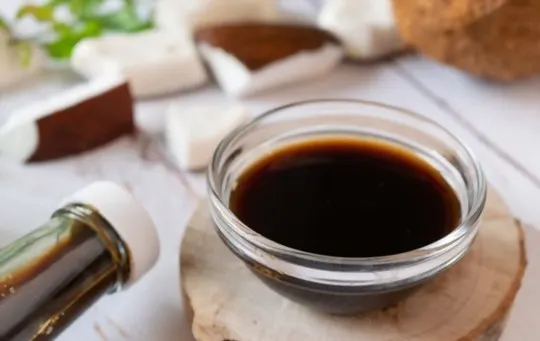
Most people are familiar with soy sauce as a common condiment, but fewer have heard of coconut aminos.
Both are made by fermenting soybeans, but coconut aminos are created using coconut palm sugar and salt instead of wheat.
This gives them a slightly sweeter flavor than soy sauce and lower sodium content.
Coconut aminos also contain seventeen amino acids, making them a good source of protein.
In addition, they are rich in vitamins B and C and minerals such as potassium and iron.
For those looking for a gluten-free or Paleo-friendly alternative to soy sauce, coconut aminos offer a delicious and nutritious option.
When substituting for soy sauce, keep in mind that the flavor will be slightly sweeter.
You may also want to add a bit more salt to your dish to compensate for the lower sodium content of coconut aminos.
- Key Characteristics: Coconut aminos have a sweet and slightly salty flavor. They are a soy-free and gluten-free alternative to liquid aminos, making them suitable for those with dietary restrictions.
- Proper Ratio: Use an equal amount of coconut aminos as a substitute for liquid aminos. Adjust other seasonings based on the desired flavor profile.
4. Fish Sauce
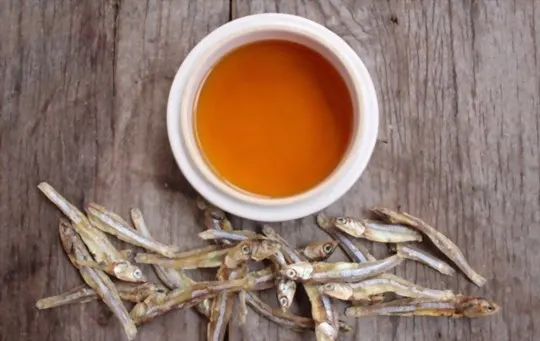
Fish sauce is a staple ingredient in many Asian cuisines.
It is made by fermenting fish in saltwater for months or even years, then straining off the Liquid and bottling it.
A thick, dark sauce with a strong, umami-rich flavor.
Fish sauce can be used as a dipping sauce, added to soups and stews, or marinade.
It is an indispensable ingredient in many Thai and Vietnamese dishes, and it can also be used to add depth of flavor to other Asian cuisines.
Fish sauce may not be to everyone’s taste, but it can be a delicious way to add complexity to a dish for those who enjoy it.
When substituting fish sauce for liquid aminos, start with a small amount and add more to the taste.
- Key Characteristics: Fish sauce adds a pungent and savory flavor to dishes. It is commonly used in Southeast Asian cuisine and can be used to add depth and complexity as a substitute for liquid aminos.
- Proper Ratio: Use half the amount of fish sauce compared to liquid aminos in recipes. Adjust other seasonings to achieve the desired taste.
5. Anchovies

At first glance, anchovies may not seem like the most delicious foods.
These small, oily fish are often associated with pizza and Caesar salads, and their strong flavor can be off-putting to some.
However, anchovies are a delicious and versatile ingredient that can add a unique depth of flavor to many dishes.
When used sparingly, they can enhance the flavor of soups, sauces, and other dishes without overwhelming the palate.
Anchovies are also a good source of omega-3 fatty acids, essential for a healthy heart and brain.
If you want to try using anchovies as a Liquid Aminos substitute, start adding them to your favorite recipes in small amounts.
You can also find anchovy paste, which is a convenient way to add the flavor of anchovies to dishes without having to deal with the whole fish.
- Key Characteristics: Anchovies provide an intense umami flavor and are commonly used as a flavor enhancer. They can be mashed or used as a paste to add depth and richness to dishes.
- Proper Ratio: Use 1-2 mashed anchovies or 1 teaspoon of anchovy paste as a substitute for liquid aminos. Adjust other seasonings based on personal preference.
Conclusion
Liquid aminos are a great way to add flavor to your food, but they’re not the only option.
There are plenty of other ingredients that can boost flavor your dishes.
From Tamari to salty anchovies, there are many options to choose from.
When substituting liquid aminos, consider the flavors of the other ingredients in your dish.
With a little experimentation, you’ll find a substitute that you love.
Have you ever used a Liquid Aminos substitute? What’s your favorite ingredient to use in place of liquid aminos? Let us know in the comments below.
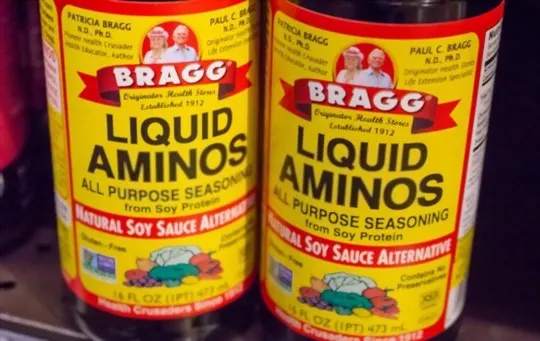
The 5 Best Substitutes for Liquid Aminos
Ingredients
- Tamari
- Soy Sauce
- Coconut Aminos
- Fish Sauce
- Anchovies
Instructions
- Pick your favorite substitute from the list above.
- Follow cooking directions for your selected substitute with the proper ratio of ingredients.

Andrew Gray is a seasoned food writer and blogger with a wealth of experience in the restaurant and catering industries. With a passion for all things delicious, Andrew has honed his culinary expertise through his work as a personal chef and caterer.
His love for food led him to venture into food writing, where he has contributed to various online publications, sharing his knowledge and insights on the culinary world. As the proud owner of AmericasRestaurant.com, Andrew covers a wide range of topics, including recipes, restaurant reviews, product recommendations, and culinary tips.
Through his website, he aims to inspire and educate fellow food enthusiasts, offering a comprehensive resource for all things food-related.

Leave a comment